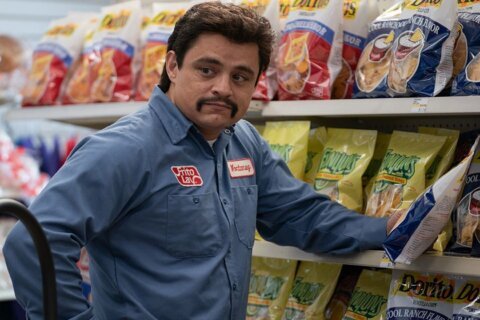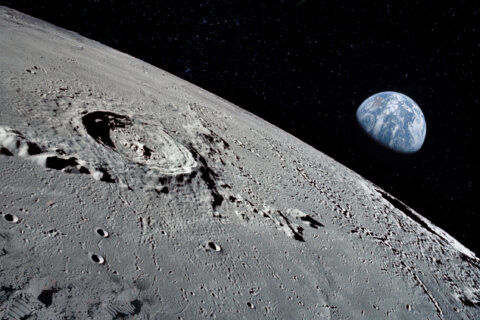Jason Fraley, WTOP film critic
WASHINGTON – Fasten your seatbelts. Another blockbuster franchise is upon us.
Suzanne Collins’ bestseller “The Hunger Games” is set to become the latest young adult book series to make a killing at the box office. The film hits theaters nationwide Friday, and The New York Times predicts it could make $90 million in its opening weekend, matching “Harry Potter and the Sorcerer’s Stone” (2001) and crushing the $69 million for “Twilight” (2008).
The film is set in a dystopian future, where the oppressive Capitol government selects a boy and a girl from each of its 12 districts to fight to the death in a live reality TV show. In order to protect her sister Primrose (Willow Shields), selfless heroine Katniss Everdeen (Jennifer Lawrence) volunteers to represent the underdog District 12, along with old acquaintance Peeta Mellark (Josh Hutcherson). With a sassy attitude, flaming costume and deadly bow-and-arrow skills, Katniss quickly wins the crowd. But can she win the games as the last contestant standing?
While it loses originality points to the Japanese film “Battle Royale” (2000) and the Stephen King adaptation “The Running Man” (1987), “The Hunger Games” provides another fascinating commentary on reality TV. It’s “Survivor” with weapons and without immunity. And when the tribe has spoken, are Katniss and Peeta really so different from Omarosa and Ereka? Ruben and Clay? Newt and Mitt? All are trying to “outwit, outplay, outlast,” and we viewers rise and fall through them.
Unlike “Twilight’s” Kristen Stewart, Jennifer Lawrence lends some Oscar-nominated cred to “The Hunger Games” after her power performance in “Winter’s Bone” (2010). Each decade seems to offer another strong action heroine. In 1979, it was Sigourney Weaver’s Ellen Ripley in “Alien.” In 1991, it was Jodie Foster’s Clarice Starling in “The Silence of the Lambs.” In 2001, it was Angelina Jolie’s Lara Croft in “Tomb Raider.” Now, Katniss Everdeen joins Lisbeth Salander (“The Girl with a Dragon Tattoo”) in a new generation of badass heroines. As the Hollywood sequels churn out, expect Jennifer Lawrence and Rooney Mara to grow in pop culture stature.
Aside from Lawrence, the real show-stealer is Woody Harrelson as the drunken victor Haymitch Abernathy. Don’t look now, but Harrelson is on a roll: “No Country for Old Men” (2007), “Zombieland” (2009), “The Messenger” (2009) and HBO’s “Game Change” (2012). Rounding out the cast are Donald Sutherland (“M*A*S*H”) as President Snow, Wes Bentley (“American Beauty”) as Seneca Crane, Elizabeth Banks (“The 40-Year-Old Virgin”) as Effie Trinket, and Lenny Kravitz as Cinna. Most curious is the casting of baby-faced Liam Hemsworth and Josh Hutcherson. Are they branching into darker roles? Or will we see teeny-bopper followings of Team Gale vs. Team Peeta?
In a way, the casting of Peeta and Gale fit the tame sensibilities of writer/director Gary Ross, who’s known around Tinseltown for his “family movie” reputation. Did Lionsgate tap him to appeal to the “Twilight” demographic, maintain a PG-13 rating and allow teenagers to fork over their weekly allowances at the ticket window? Or, was he chosen for his experience in two of the film’s key genres: sports (“Seabiscuit”) and coming-of-age fantasies (“Big”)?
Unlike Mel Gibson’s approach to “Braveheart” (1995), Ross rarely shows us the deathblows, which usually happen off screen, revealed in a pan to see an arrow already in a stomach. This can be just as effective; John Ford did it in “Stagecoach” (1939). What lacks is any overall sense of daring from Ross. To his credit, he maximizes sound design, dropping sound out or bringing a hum in at precise moments. To his discredit, he hardly experiments with the camera, lacking the unique reality show perspectives, fisheye lenses and voyeuristic camera angles Peter Weir explored in “The Truman Show” (1998). I can’t help but wonder what it would have looked like in the hands of one of today’s more dangerous young directors: Darren Aronofsky, David Fincher or P.T. Anderson. In short, “The Hunger Games” is a competently directed adaptation of a great story; it’s just not all that cinematic.
The book itself was made for the screen, with Collins even providing a description of the reality show cameras cutting from shot to shot (at 19 percent on your Kindle). Ross does a faithful job at bringing the book’s small details to the screen, from the three-finger crowd salute, to Peeta standing to the right of Katniss as they enter the Games. Their flaming entrance is everything I imagined it would be (a literal “Chariots of Fire”), and the arrow-through-the-apple scene translates perfectly.
On the downside, many things work much better in the book. Some of the choices — changing the origin of the mockingjay pin and downplaying the Avox character — are understandable under the time constraints. But the movie gives away the book’s powerful double-whammy twist during the Reaping by inserting an overt dialogue set-up from Primrose in the opening minutes. You’ll see what I mean.
Overall, the subject matter works way better as a book trilogy than it does a standalone movie. It’s hard to compare “The Hunger Games” to movie masterpieces like “Ben-Hur” (1959), “Spartacus”(1960) or “Gladiator” (2000), because those films are self-contained works, while “The Hunger Games” feels unfinished. I kept craving the movie to take on the overarching system of Capitol oppression, because as moviegoers, we crave a confrontation with the main antagonist (villain).
This week, I had the chance of seeing a 70th anniversary screening of “Casablanca” in Arlington, and it highlighted my issue with “The Hunger Games.” While Humphrey Bogart can’t take down all of Nazi Germany in two hours, he’s given a proxy villain to defeat in Major Strasser. In “Ben-Hur,” Charlton Heston can’t take down the whole Roman Empire, but he’s given Messala to defeat in a thrilling chariot race. “Hunger Games” tries to give us Cato as a proxy villain for President Snow and the Capitol, but he’s not built up into enough of a threat. His leadership of the Career Tributes is much more effective in the book, while the movie fails to play up moments like his snapping the neck of the District 3 kid at the supply pile.
Similarly, the “standalone” nature of “Spartacus,” “Braveheart” and “Gladiator” allows for the glory of martyrdom, where the hero’s sacrificial death rallies the cause to defeat the larger enemy. “Hunger Games” flirts with this elegant, bittersweet, “Romeo and Juliet”-style finale … but we know there are two more books to finish.
For all this, “The Hunger Games” leaves us starving for more, and depending how many movies you’ve seen, your cravings will vary. Film novices will feel differently encountering this story for the first time than film buffs who instantly recognize the plot from “The Running Man” and miss the closure of self-contained epics like “Ben-Hur” and “Spartacus.” If you’re one of the former, imagine another movie series coming decades from now that rips off “The Hunger Games.” You might feel slightly different about it.
To me, the movie feels like a 3-star rendition of a 4-star teen novel. And by that I mean you should absolutely experience both. If not, you’re missing out on a giant piece of today’s pop culture. The two-plus hours fly by, providing a thrill ride for fans of the book and non-fans alike.
Happy Hunger Games, Lionsgate.
May the odds of box office receipts and critics reviews be ever in your favor.
★ ★ ★
The above rating is based on a 4-star system. Read more from WTOP Film Critic Jason Fraley by clicking “Fraley on Film” under the “Living” tab above, and check out his blog, The Film Spectrum.
(Copyright 2012 by WTOP. All Rights Reserved.)








